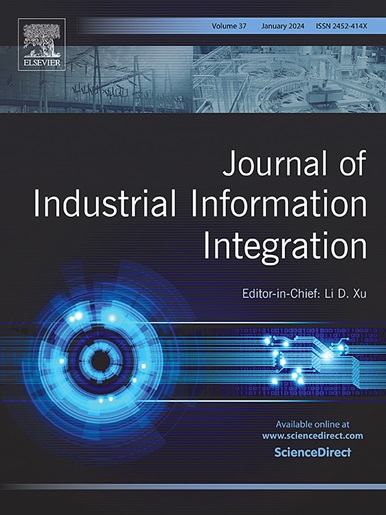工业5.0中流程优化的机器学习集成数字孪生
IF 10.4
1区 计算机科学
Q1 COMPUTER SCIENCE, INTERDISCIPLINARY APPLICATIONS
引用次数: 0
摘要
本研究通过提出一种混合模型来应对工业5.0的挑战,该模型将常微分方程(ode)与机器学习(ML)算法集成在数字孪生(DT)架构中。该方案应用于一家洗涤剂制造厂,更新了专注于可持续性、弹性和以人为本的流程。该研究是在一个真实的工业工厂中进行的,从SCADA、MES和ERP系统收集了操作数据。本文提出了一个混合模型,该模型集成了机器学习(ML)、常微分方程(ode)和数字孪生框架,用于制造业的流程优化。这些变量在模块化架构中进行处理,并在ISO 23247框架内进行测试,通过人机界面(HMI)进行实时可视化。混合方法在预测化学溶液(R²= 0.80)、磺酸消耗(R²= 0.9998)和智能反应器分配(准确率为80.7%)方面有显著提高。此外,该系统预测实验室延迟的准确率为78.1%,并显著减少了装载时间和操作偏差。相比之下,烧碱、水和月桂等原材料的预测性能较低,这加强了对额外解释变量的需求。该模型增强了预测人工智能与物理建模相结合的潜力,以实现更可持续、更有弹性和更以人为本的决策。将ML和ode集成到DT中可以促进洗涤剂行业的运营和战略收益,符合工业5.0的原则。该方法有效、可扩展,能够将工业数据转化为优化决策,直接影响生产过程的效率、可持续性和自主性。本文章由计算机程序翻译,如有差异,请以英文原文为准。
Machine Learning-integrated digital twins for process optimization in Industry 5.0
This study responds to the challenges of Industry 5.0 by proposing a hybrid model that integrates Ordinary Differential Equations (ODEs) with Machine Learning (ML) algorithms within a Digital Twin (DT) architecture. The proposal is applied to a detergent manufacturing plant, updating processes focusing on sustainability, resilience, and human-centeredness. The study was conducted in a real industrial plant, with operational data collected from SCADA, MES, and ERP systems. This paper proposes a hybrid model that integrates Machine Learning (ML), Ordinary Differential Equations (ODEs), and a Digital Twin framework for process optimization in the manufacturing industry. The variables were treated in modular architecture and tested within the ISO 23247 framework, with real-time visualizations through human-machine interfaces (HMI). The hybrid approach showed significant gains in predicting chemical solutions (R² = 0.80), sulfonic acid consumption (R² = 0.9998), and intelligent reactor allocation (80.7 % accuracy). In addition, the system predicted laboratory delays with 78.1 % accuracy and enabled significant reductions in loading times and operational deviations. In contrast, raw materials such as caustic soda, water, and laurel showed lower predictive performance, reinforcing the need for additional explanatory variables. The model enhances the potential of predictive AI combined with physical modeling for more sustainable, resilient, and human-centered decisions. Integrating ML and ODEs into a DT promotes operational and strategic gains for the detergent industry, aligning with the principles of Industry 5.0. The demonstrated approach is effective, scalable, and capable of transforming industrial data into optimized decisions, directly impacting the production process's efficiency, sustainability, and autonomy.
求助全文
通过发布文献求助,成功后即可免费获取论文全文。
去求助
来源期刊

Journal of Industrial Information Integration
Decision Sciences-Information Systems and Management
CiteScore
22.30
自引率
13.40%
发文量
100
期刊介绍:
The Journal of Industrial Information Integration focuses on the industry's transition towards industrial integration and informatization, covering not only hardware and software but also information integration. It serves as a platform for promoting advances in industrial information integration, addressing challenges, issues, and solutions in an interdisciplinary forum for researchers, practitioners, and policy makers.
The Journal of Industrial Information Integration welcomes papers on foundational, technical, and practical aspects of industrial information integration, emphasizing the complex and cross-disciplinary topics that arise in industrial integration. Techniques from mathematical science, computer science, computer engineering, electrical and electronic engineering, manufacturing engineering, and engineering management are crucial in this context.
 求助内容:
求助内容: 应助结果提醒方式:
应助结果提醒方式:


